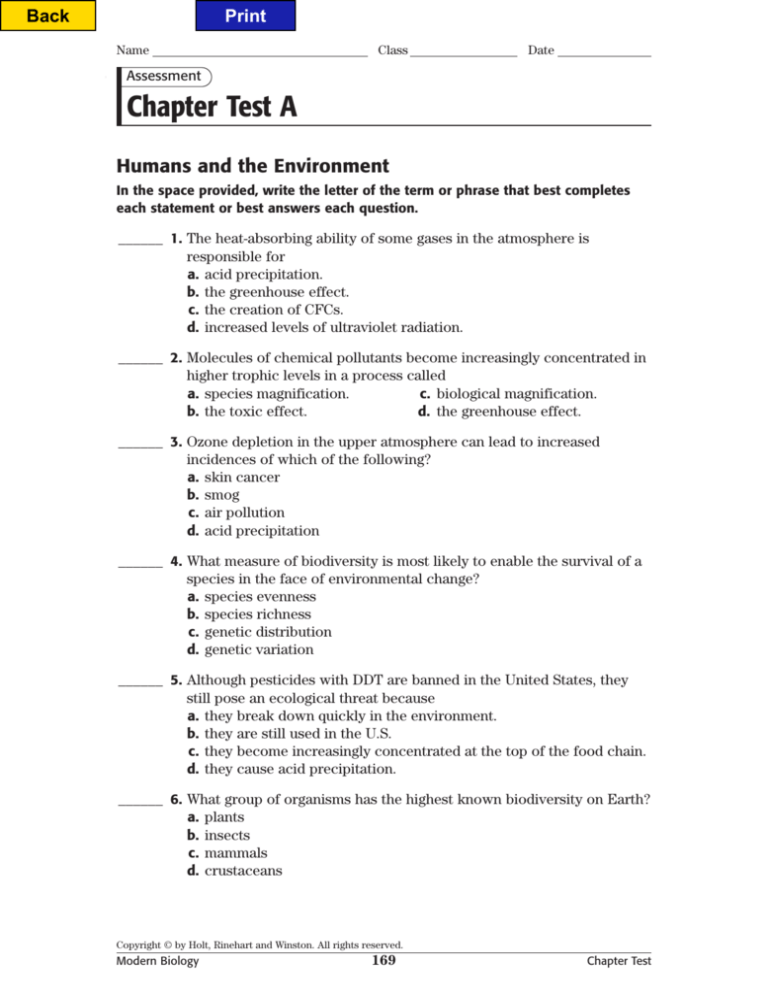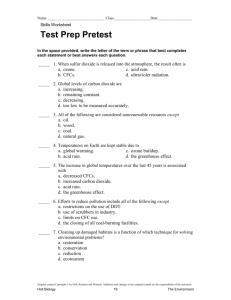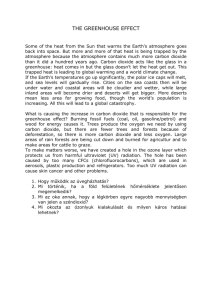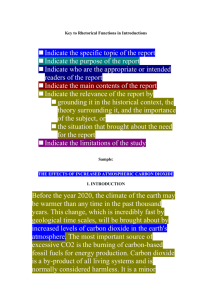
Back
Print
Name
Class
Date
Assessment
Chapter Test A
Humans and the Environment
In the space provided, write the letter of the term or phrase that best completes
each statement or best answers each question.
______ 1. The heat-absorbing ability of some gases in the atmosphere is
responsible for
a. acid precipitation.
b. the greenhouse effect.
c. the creation of CFCs.
d. increased levels of ultraviolet radiation.
______ 2. Molecules of chemical pollutants become increasingly concentrated in
higher trophic levels in a process called
a. species magnification.
c. biological magnification.
b. the toxic effect.
d. the greenhouse effect.
______ 3. Ozone depletion in the upper atmosphere can lead to increased
incidences of which of the following?
a. skin cancer
b. smog
c. air pollution
d. acid precipitation
______ 4. What measure of biodiversity is most likely to enable the survival of a
species in the face of environmental change?
a. species evenness
b. species richness
c. genetic distribution
d. genetic variation
______ 5. Although pesticides with DDT are banned in the United States, they
still pose an ecological threat because
a. they break down quickly in the environment.
b. they are still used in the U.S.
c. they become increasingly concentrated at the top of the food chain.
d. they cause acid precipitation.
______ 6. What group of organisms has the highest known biodiversity on Earth?
a. plants
b. insects
c. mammals
d. crustaceans
Copyright © by Holt, Rinehart and Winston. All rights reserved.
Modern Biology
169
Chapter Test
Back
Print
Name
Class
Date
Humans and the Environment, Chapter Test A continued
Refer to the figure below to answer questions 7 and 8.
0.4
340
320
0.2
CO2
0.0
300
–0.2
280
Temperature
260
1860
–0.4
–0.6
1890
1920
1950
Temperature change (°C)
(parts per million)
Concentration of CO2
Amount of Carbon Dioxide in the Atmosphere and
Average Global Temperature Change
1980
Year
______ 7. The graph above shows
a. that there is probably no relationship between temperature and
carbon dioxide concentration.
b. that both the average global temperature and the carbon dioxide
concentration were higher in 1980 than in 1860.
c. that the concentration of oxygen in the atmosphere has increased
since 1860.
d. that the concentration of carbon dioxide in the atmosphere has
decreased since 1860.
______ 8. According to the graph above,
a. the average global temperature remained constant from
1900 to 1950.
b. the concentration of carbon dioxide in the atmosphere is too high.
c. the concentration of carbon dioxide remained constant from
1890 to 1940.
d. the average global temperature has increased since 1890.
In the space provided, write the letter of the description that best matches the
term or phrase.
______ 9. ecotourism
a. portion of Earth that is water
b. tourism that supports conservation
______10. CFCs
______11. hydrosphere
c. species that is very sensitive to
ecological disturbance
______12. smog
d. chemicals used as coolants that
break down and destroy ozone
______13. atmosphere
e. gaseous envelope around Earth
______14. bioindicator
f. visible pollution which is a mix of
water vapor and chemicals
Copyright © by Holt, Rinehart and Winston. All rights reserved.
Modern Biology
170
Chapter Test
Back
Print
Name
Class
Date
Humans and the Environment, Chapter Test A continued
Complete each statement by writing the correct term or phrase in the space provided.
15. The
is made up of all the water on Earth.
16. The variety of organisms in an area is known as
.
17. When habitats are disrupted, some organisms may face
.
18. In cities, air pollution can result in visible
19. A
.
is one species that affects many other species
in a community.
Read each question, and write your answer in the space provided.
20. What kinds of action can individuals take to help solve environmental problems?
21. Explain what “sustainability” is.
22. Explain why acid precipitation was not an environmental issue 200 years ago.
23. Why is it important to prevent the extinction of species?
24. What do scientists know about the relationship between the greenhouse
effect and global warming?
25. How does the presence of the ozone layer affect life on Earth?
Copyright © by Holt, Rinehart and Winston. All rights reserved.
Modern Biology
171
Chapter Test
Back
Print PAGE
TEACHER RESOURCE
23. The three types of grasslands are
24.
25.
26.
27.
28.
29.
30.
temperate grasslands, savannas, and
chaparral. Temperate grasslands are
characterized by thick, rich soils, with
dense, tall grasses in moist areas and
short grasses in drier areas. Savannas
have dry, thin, porous, and nutrientpoor soils, with tall grasses and scattered trees. Chaparral areas have
thick, rocky, nutrient-poor soil, with
evergreen shrubs and scattered trees.
Trees are rare because of the short
growing season and because the
permafrost doesn’t allow the tree
roots to penetrate down into the soil.
The forest floors of tropical rain forests
are relatively free of vegetation because
little sunlight can penetrate the thick
forest canopy down to the forest floor.
Organisms that live in the intertidal
zone must be able to tolerate periodic
exposure to air and avoid dehydration.
They must also be able to withstand
the force of strong waves.
Freshwater wetlands are important
because they filter pollutants out of
the water that flows through them,
they provide spawning grounds for
many economically important species,
they are important stopovers for
migratory birds, they are home to
many endangered species, and they
control flooding.
Tropical rain forests are located near
the equator and have year-round growing seasons, abundant precipitation, tall
trees, and the highest species richness
of all biomes. Temperate deciduous
forests are located farther from the
equator and have pronounced seasons,
lower annual precipitation, and lower
species richness than tropical rain
forests do.
Lakes and ponds are characterized
as either eutrophic or oligotrophic.
Eutrophic lakes and ponds are rich
in organic matter and vegetation.
Oligotrophic lakes and ponds contain
little organic matter.
(a) savanna, (b) tropical forest,
(c) temperature: approximately 6º C
to 5º C; precipitation: approximately 0
cm to 200 cm, (d) approximately 125 cm
to 450 cm.
Humans and the
Environment
Chapter Test A (General)
1.
2.
3.
4.
5.
6.
7.
15.
16.
17.
18.
19.
20.
21.
22.
23.
24.
b
8. d
c
9. b
a
10. d
d
11. a
c
12. f
b
13. e
b
14. c
hydrosphere
biodiversity
extinction
smog
keystone
Sample answer: Knowledge of ecology
is an essential tool to solving environmental problems. Individuals can take
steps to conserve energy such as by
using bicycles or public transportation
and by recycling or other conservation
efforts.
Sustainability is the desired condition
of the relationship between humans
and the environment. It means the wise
use of renewable resources in a way
that will enable the human population
to survive indefinitely.
Acid precipitation began to be produced
when industries and cars began to
release air polluntants that combined
with water vapor in the atmosphere to
form acidic precipitation. Such sources
of air pollution did not exist 200 years
ago.
Many species offer possible benefits to
humans, and we could lose our chance
to learn about these species. For
example, plant and animal species
are used as food and medicine.
Since 1960, the levels of carbon dioxide
in the atmosphere and the average
global temperature have both risen
steadily. The correlation of increasing
temperatures with increasing carbon
dioxide levels is very close. Many
scientists believe that the two are
related. However, correlation does
not prove cause and effect. Both
global temperature and levels of
greenhouse gases may be changing
because of other variables that have
not yet been recognized.
Copyright © by Holt, Rinehart and Winston. All rights reserved.
Modern Biology
423
Answer Key
Back
Print PAGE
TEACHER RESOURCE
25. The ozone layer protects life on Earth
from ultraviolet radiation from the sun.
Humans and the
Environment
Chapter Test B (Advanced)
1.
2.
3.
4.
5.
6.
7.
8.
9.
10.
11.
12.
24.
25.
26.
27.
28.
c
13. l
d
14. a
b
15. d
g
16. c
h
17. c
e
18. c
a
19. b
f
20. d
m
21. d
i
22. a
k
23. c
j
The greenhouse effect has a positive
effect on life on Earth. Without the
greenhouse effect Earth would be too
cold to support life as we know it.
A thinning of the ozone layer would
allow more ultraviolet radiation to
reach Earth’s surface, possibly resulting in an increase in mutations, such
as those that cause skin cancer, in
humans and other organisms.
Upper atmospheric ozone levels are
expected to decrease. Atmospheric
carbon dioxide levels are expected to
increase. Global temperature is
expected to increase. Undeveloped
land areas are expected to decrease,
and various natural resources, such as
clean water, fossil fuels, and forested
areas, are expected to decrease.
Humans have caused biodiversity to
decrease by causing extinctions of
other species, through pollution, overhunting, and habitat destruction from
activities such as mining, agriculture,
and construction. However, humans
have also tried to protect and restore
biodiversity in some cases.
Both debt-for-nature swaps and ecotourism originated to help conserve
biodiversity in poor countries. In a
debt-for-nature swap, a richer country
or private organization pays some of
the debts of a poorer country in
exchange for the poorer country’s
taking steps to protect its biodiversity.
In ecotourism, natural areas are
preserved in order to attract tourist
business.
29. Some problems that have been faced
in the attempt to reintroduce whooping cranes include the low genetic
diversity of the species; the need to
recreate aspects of the crane’s behavior,
such as the courtship dance, to insure
that the birds will successfully mate;
and the need to teach the young
cranes the migration route using small
aircraft. Other problems include the
need to protect the crane’s habitat
along the entire migration route.
30. (a) release of chemicals into the environment (b) increased atmospheric
carbon dioxide levels and global warming (c) biodiversity (d) debt-for-nature
swaps or ecotourism (e) conservation
efforts (f) reintroducing the whooping
crane
Bacteria
Chapter Test A (General)
1.
2.
3.
4.
5.
6.
7.
8.
9.
10.
11.
23.
b
12. d
d
13. d
d
14. c
c
15. h
b
16. g
b
17. b
d
18. a
c
19. f
a
20. d
d
21. e
a
22. i
any four of the following: cholera,
tooth decay, anthrax, Lyme disease,
botulism, gonorrhea, tuberculosis,
food poisoning
24. Bacteria can be identified and classified
by their shapes, by their reaction to
Gram staining, by their biochemical
properties, and by their evolutionary
relationships.
25. Bacteria secrete exotoxins into their
environment. These toxins, which are
poisonous to eukaryotic cells, can
cause disease. Bacteria also produce
endotoxins, which are released when
the cell dies.
Copyright © by Holt, Rinehart and Winston. All rights reserved.
Modern Biology
424
Answer Key









